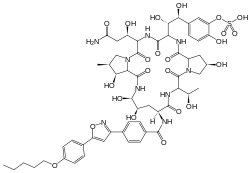Micafungin
 | |
|---|---|
 | |
| Systematic (IUPAC) name | |
| {5-[(1S,2S)-2-[(3S,6S,9S,11R,15S,18S,20R,21R,24S,25S,26S)-3-[(1R)-2-carbamoyl-1-hydroxyethyl]-11,20,21,25-tetrahydroxy-15-[(1R)-1-hydroxyethyl]-26-methyl-2,5,8,14,17,23-hexaoxo-18-[(4-{5-[4-(pentyloxy)phenyl]-1,2-oxazol-3-yl}benzene)amido]-1,4,7,13,16,22-hexaazatricyclo[22.3.0.09,13]heptacosan-6-yl]-1,2-dihydroxyethyl]-2-hydroxyphenyl}oxidanesulfonic acid | |
| Clinical data | |
| Trade names | Mycamine |
| AHFS/Drugs.com | monograph |
| Licence data | EMA:Link, US FDA:link |
| Pregnancy cat. | C |
| Legal status | ℞ Prescription only |
| Routes | Intravenous |
| Pharmacokinetic data | |
| Protein binding | 99.8% |
| Metabolism | Via catechol-O-methyltransferase pathway |
| Half-life | 11–17 hours |
| Excretion | 40% feces, <15% urine |
| Identifiers | |
| CAS number | 235114-32-6 |
| ATC code | J02AX05 |
| PubChem | CID 477468 |
| DrugBank | DB01141 |
| ChemSpider | 21106351 |
| UNII | R10H71BSWG |
| KEGG | D02465 |
| ChEMBL | CHEMBL1201351 |
| Chemical data | |
| Formula | C56H71N9O23S |
| Mol. mass | 1270.28 g/mol |
| |
| | |
Micafungin (trade name Mycamine) is an echinocandin antifungal drug developed by Astellas Pharma. It inhibits the production of beta-1,3-glucan, an essential component of fungal cell walls. Micafungin is administered intravenously. It received final approval from the U.S. Food and Drug Administration on March 16, 2005, and gained approval in the European Union on April 25, 2008.
Indications
Micafungin is indicated for the treatment of candidemia, acute disseminated candidiasis, Candida peritonitis, abscesses and esophageal candidiasis. Since January 23, 2008, micafungin has been approved for the prophylaxis of Candida infections in patients undergoing hematopoietic stem cell transplantation (HSCT).
Micafungin works by way of concentration-dependent inhibition of 1,3-beta-D-glucan synthase resulting in reduced formation of 1,3-beta-D-glucan, which is an essential polysaccharide comprising one-third of the majority of Candida spp. cell walls. This decreased glucan production leads to osmotic instability and thus cellular lysis. [1] [2]
Contraindications
Known hypersensitivity to micafungin or any other ingredient contained in the formulation is a contraindication for its use.
Dosage
For the treatment of candidemia, acute disseminated candidiasis, Candida peritonitis, and abscesses, the dosage of micafungin is 100 mg once daily. For the treatment of esophageal candidiasis, the dosage is 150 mg once daily. For prophylaxis of Candida infections in HSCT recipients, the dosage is 50 mg once daily.
The metabolism of micafungin occurs hepatically as the drug molecule is a substrate of CYP3A4; a liver enzyme. Precautions should be taken with regards to dosing, as micafungin also inhibits its own clearance via weak CYP3A4 inhibition. [3] [4]
Dosage forms
Micafungin is a natural antifungal product derived from other fungi as a defense mechanism for competition of nutrients, etc. To be specific, micafungin is derived from FR901379, and is produced by Coleophoma empetri. [5] [6]
- Mycamine 50mg for intravenous (IV) infusion (manufacturer Astellas)
- Mycamine 100mg for IV infusion (manufacturer Astellas)
- Brand names in countries other than the US may vary.
References
- ↑ Pappas PG, Rotstein CM, Betts RF, et al, “Micafungin vVersus Caspofungin for Treatment of Candidemia and Other Forms of Invasive Candidiasis,” Clin Infect Dis, 2007, 45(7):883-93. [PubMed 17806055]
- ↑ Pettengell K, Mynhardt J, Kluyts T, et al, “Successful Treatment of Oesophageal Candidiasis by Micafungin: A Novel Systemic Antifungal Agent,” Aliment Pharmacol Ther, 2004, 20(4):475-81. [PubMed 15298643]
- ↑ Carver PL, “Micafungin,” Ann Pharmacother, 2004, 38(10):1707-21. [PubMed 15340133]
- ↑ Kohno S, Masaoka T, Yamaguchi H, et al, “A Multicenter, Open-Label Clinical Study of Micafungin (FK463) in the Treatment of Deep-Seated Mycosis in Japan,” Scand J Infect Dis, 36(5):372-9
- ↑ The Journal of Antibiotics (2009) 62, 27-35
- ↑ Fujie, Akihiko, Discovery of Micafungin (FK463): A novel antifungal derived from a novel product lead. Fermentation Research Laboratories, Astellas Pharma Inc., 5-2-6-Tokodai, Tsukuba, Ibaraki 300-2698, japan. Pure Appl. Chem, Vol. 79, No. 4, pp. 603-614, 2007
External links
- Mycamine website, run by Astellas Pharma US
- Mycamine Prescribing Information
- Gregory Eschenauer, Daryl D DePestel, and Peggy L Carver: Comparison of echinocandin antifungals. Ther Clin Risk Manag 2007, 3(1): 71–97.
| ||||||||||||||||||||||||||||||||||||||||||||||